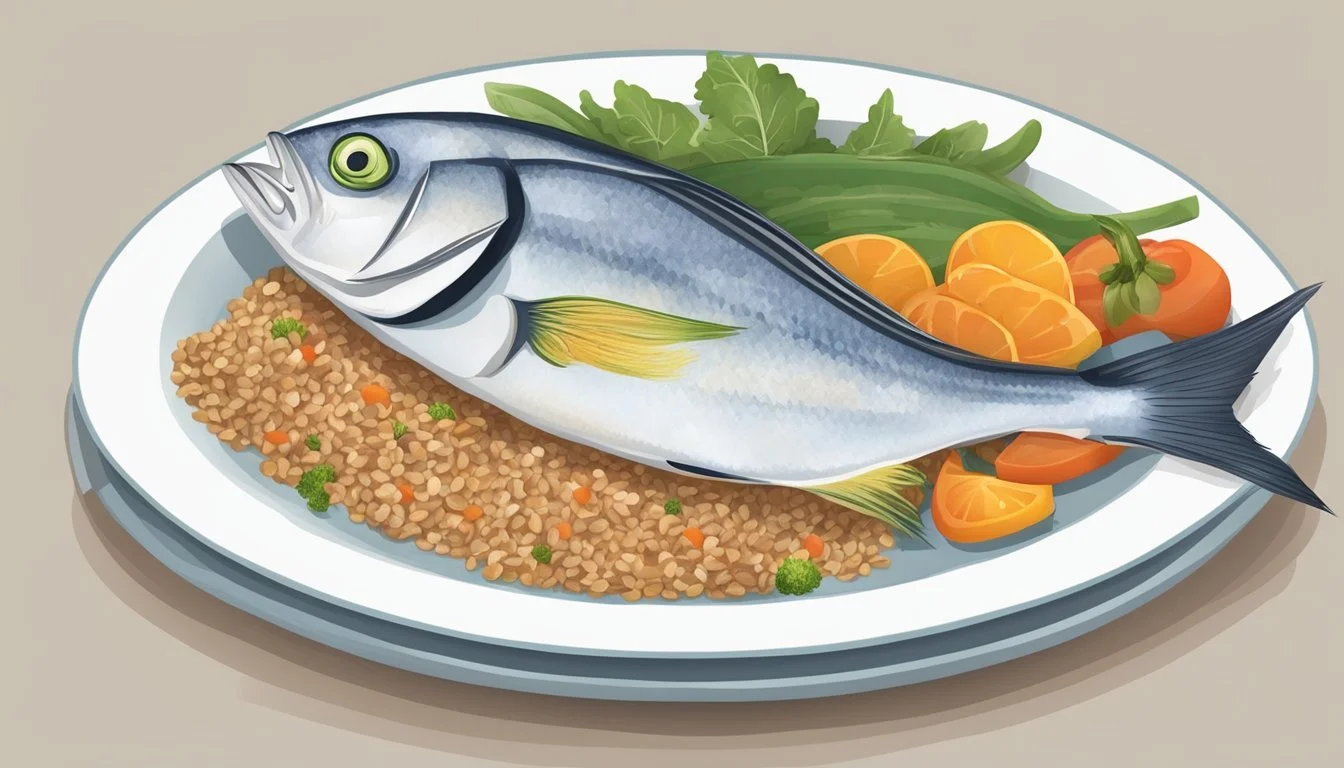Can Diabetics Eat Pompano?
Understanding Its Benefits and Risks
For those navigating the nuances of diabetes management, dietary choices are crucial. One often-asked question is: Can diabetics eat Pompano fish? The answer is yes. Pompano fish, known for its lean protein content and low glycemic index, fits well into a diabetic diet by providing essential nutrients without causing sharp spikes in blood sugar levels.
Pompano is a sustainable seafood option that is not overfished and is farmed in controlled environments. This makes it a responsible choice for those mindful of both their health and the environment. The fish is rich in proteins and healthy fats, which are beneficial in maintaining balanced blood sugar levels, making it a suitable addition to a diabetic diet.
Incorporating Pompano into meals can offer variety and flavor while supporting nutritional needs. The key is moderation and balance, pairing Pompano with other low-glycemic foods and vegetables to create a wholesome and satisfying meal plan.
Understanding Diabetes and Dietary Needs
Diet plays a crucial role in managing diabetes by helping control blood sugar levels and providing essential nutrients required by the body. Specific dietary choices and patterns can significantly influence blood sugar control and insulin sensitivity, particularly for those with type 2 diabetes.
The Impact of Diet on Diabetes Management
Diet is a vital component in managing diabetes. One major goal is to maintain blood sugar levels within a target range. This entails monitoring and adjusting intake of carbohydrates, proteins, and fats.
Consuming non-starchy vegetables, lean proteins, and healthy fats is beneficial. People with diabetes are advised to limit refined carbohydrates and sugary foods that can cause blood sugar spikes.
Macronutrients and Blood Sugar Control
Carbohydrates have the most immediate impact on blood sugar levels. Monitoring carbohydrate intake helps manage post-meal glucose spikes. Including high-fiber foods can slow down carbohydrate absorption and help maintain steady blood sugar levels.
Proteins are essential for bodily functions and can help stabilize blood sugar when paired with carbohydrates. Sources like fish, lean meat, poultry, and plant-based proteins are recommended. Fats, particularly healthy fats such as those from nuts, seeds, and fish, can further aid in controlling blood sugar by promoting satiation and reducing carbohydrate intake.
The Nutritional Profile of Pompano
Pompano fish is known for its nutrient-rich composition, providing a range of essential macronutrients, vitamins, and minerals. This makes it a suitable option for those seeking a balanced diet.
Macronutrient Breakdown
Pompano fish is particularly known for its high protein content. A 100-gram serving contains approximately 20-23 grams of protein, which supports muscle growth and repair. Additionally, it is relatively low in calories, containing around 95-211 calories per 100 grams, depending on the source.
Fat Content in pompano is moderate. It offers roughly 10 grams of total fat per 100 grams, including beneficial omega-3 fatty acids. These fats are crucial for heart health and cognitive function. Saturated fat is present but in lower quantities compared to healthier unsaturated fats.
Cholesterol levels in pompano are notable but not excessive, making it a more heart-friendly option compared to other meat sources.
Vitamins and Minerals in Pompano
Pompano fish provides a wealth of essential vitamins and minerals. Notably, it is rich in Vitamin B12, with around 1.06 µg per serving, crucial for nerve function and red blood cell production. Vitamin B1 (Thiamin) and Vitamin B3 (Niacin) are also present, supporting energy metabolism.
In terms of minerals, pompano offers significant amounts of selenium and phosphorus. Selenium, at 41.2 µg per 100 grams, plays a role in antioxidant defense and thyroid function. Phosphorus, at 300 mg, is essential for bone health.
Potassium content in pompano is about 636 mg per 100 grams, promoting muscle function and fluid balance. Additional minerals such as iron and zinc are present in smaller yet beneficial amounts, contributing to overall wellness.
Benefits of Fish in a Diabetic Diet
Including fish in a diabetic diet offers various health advantages, notably in promoting heart health and providing essential nutrients. Different types of fish offer unique benefits that are pertinent for managing diabetes effectively.
Heart Health Advantages
Fish rich in omega-3 fatty acids, such as salmon, sardines, and mackerel, play a crucial role in improving heart health.
Omega-3 fatty acids help reduce triglyceride levels and may lower the risk of heart disease, which is often a concern for individuals with diabetes. These healthy fats can also aid in lowering blood pressure and reducing inflammation.
Eating fish regularly may contribute to better cholesterol levels. The reduction in LDL (bad cholesterol) and potential increase in HDL (good cholesterol) support cardiovascular health, making fish a vital component of a heart-healthy diabetic diet.
Comparing Different Types of Fish
Choosing the right type of fish is essential for maximizing health benefits.
Salmon: High in omega-3 fatty acids and protein, supports heart health and provides vitamins D and B12.
Sardines: Affordable and rich in omega-3s, calcium, and vitamin D, making them beneficial for both heart and bone health.
Tuna: Versatile and packed with lean protein and omega-3s, though care should be taken with portion sizes due to mercury levels.
Mackerel: Exceptionally high in omega-3 fatty acids and essential vitamins, but higher in calories compared to leaner fish like cod or tilapia.
Incorporating a variety of these fish types ensures a balanced intake of essential nutrients, promoting both heart and overall health for diabetics.
Risks and Considerations
When considering pompano for a diabetic diet, it is essential to pay attention to various factors like sodium intake and potential contaminants, which may affect health.
Monitoring Sodium and Cholesterol
Pompano fish is a nutritious option, but individuals with diabetes should be mindful of its sodium and cholesterol content. Excessive sodium can lead to increased blood pressure, which is crucial for diabetic individuals to manage carefully.
Cholesterol levels might also be affected by seafood consumption. While pompano fish provides healthy fats and proteins, it is essential to balance it with other low-cholesterol foods to avoid potential cardiovascular risks.
A moderate serving size and preparation method, such as grilling without additional salt, can help manage these factors.
Potential Contaminants in Seafood
Seafood, including pompano fish, may contain contaminants like mercury and PCBs (polychlorinated biphenyls). For diabetics, careful monitoring of these contaminants is essential to avoid additional health complications.
Mercury exposure can affect neurological health, while PCBs have been linked to various health issues. Choosing pompano from reputable sources and limiting the frequency of consumption can mitigate these risks.
It's advisable to integrate a variety of fish and seafood with lower contaminant levels into the diet to maintain both variety and safety.
Pompano Preparation and Serving Suggestions
Preparing pompano fish in healthy ways ensures that diabetics can enjoy this flavorful seafood without compromising their dietary needs. Suitable cooking methods and mindful portion control can make a significant difference.
Healthy Cooking Methods
For diabetics, baking, grilling, and pan-searing are ideal methods to cook pompano. Baking the fish in the oven helps retain its natural flavors and nutrients without adding extra fats. Preheat the oven to 375°F, make shallow cuts on the fish, and season with herbs and lemon juice. Bake for 20-25 minutes until the flesh is opaque.
Grilling is another excellent option. Brush pompano fillets lightly with olive oil and season as desired. Grill for 3-4 minutes on each side. To avoid excessive charring, cook over medium heat. Combining diced mango, red onion, jalapeño, cilantro, lime juice, and salt makes a refreshing salsa to serve on top.
Portion Control and Frequency
It's crucial for diabetics to monitor serving sizes and frequency of consumption. A standard serving size for pompano is around 3 to 4 ounces. This amount provides an adequate portion of protein and healthy fats without excessive calories. A 100-gram serving of pompano contains approximately 95 calories and 20 grams of protein.
Eating pompano 1-2 times per week fits well within dietary guidelines for those managing diabetes. Pairing pompano with vegetables or a small serving of whole grains ensures a balanced meal.
Limiting the use of high-fat sauces or deep frying methods can prevent unnecessary spikes in calorie and fat intake, making it safer and healthier for individuals with diabetes.
Incorporating Pompano into a Balanced Diabetic Diet
Pompano fish can be a nutritious addition to a diabetic diet, providing essential nutrients without excessively high calories or unhealthy fats. Balance and variety are key to making the most of its benefits.
Creating a Meal Plan with Variety
Creating a balanced meal plan starts with variety. Pompano, rich in protein and omega-3 fatty acids, can be paired with vegetables like leafy greens, broccoli, or bell peppers to create nutrient-dense meals.
Including whole grains such as quinoa or brown rice adds fiber that helps manage blood sugar levels. For healthy fats, consider adding avocado slices or a sprinkle of nuts and seeds.
Occasionally, substituting other lean proteins, such as chicken or beans, ensures a balanced intake of essential nutrients.
Complementary Foods for Nutritional Balance
Complementing pompano with foods high in fiber and healthy fats aids in maintaining stable blood sugar levels. Vegetables like kale, spinach, and cauliflower provide vitamins and minerals with low carb content.
Including legumes such as lentils or chickpeas boosts fiber and protein intake.
Whole grains like oats or whole wheat pasta offer consistent energy release. Healthy fats from sources like olive oil, nuts, and seeds enhance taste and nutrition. Adding a portion of fruit such as berries can offer antioxidants without spiking blood sugar excessively.
Consulting Healthcare Providers
To manage diabetes effectively and incorporate foods like Pompano into the diet, consulting healthcare providers is crucial. Key aspects include seeking personalized dietary advice and maintaining regular blood sugar monitoring.
When to Seek Advice from a Dietitian
Diabetics can benefit greatly from consulting with a registered dietitian. Dietitians provide tailored meal plans that incorporate specific dietary needs, ensuring foods like Pompano fit within the recommended guidelines. Eating a diet high in fruits, vegetables, fiber, and whole grains and low in processed foods is often crucial for managing diabetes.
The American Diabetes Association recommends that individuals consult with a dietitian when they are newly diagnosed or need adjustments to their meal plan. This professional can help balance macronutrients and other dietary components to stabilize blood sugar levels.
Regular follow-ups with a dietitian are important, especially when trying new foods or adjusting dietary patterns. This ensures that any adverse effects on blood sugar levels can be identified and corrected promptly.
Regular Monitoring of Blood Sugar Levels
Monitoring blood sugar levels is an indispensable part of diabetes management. It helps in understanding how different foods, like Pompano, affect blood glucose levels. Keeping a log of blood sugar readings before and after meals can provide insights needed for better management.
Healthcare providers often recommend periodic A1C tests, which give an average blood glucose level over the past 2-3 months. Keeping the A1C within target range reduces the risk of complications.
Regular appointments with an endocrinologist or primary care physician ensure that monitoring strategies and medications are effectively aligned. They may assist in adjusting insulin or other medications based on blood sugar trends, creating a collaborative approach to diabetes management.









